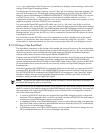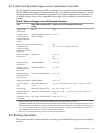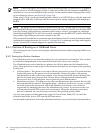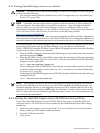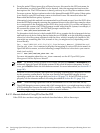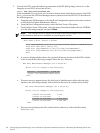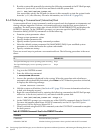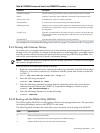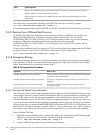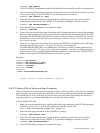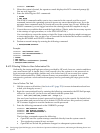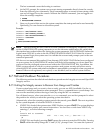
2. To boot the DVD, enter the following command at the EFI Shell prompt, where fsn: is the
Integrity servers DVD drive (such as fs0:).
Shell> fsn:\efi\boot\bootia64.efi
If this command does not work, or if you have doubts about which device maps to the DVD
drive, you can use the EFI Boot Manager menu system to boot the OE DVD, as described in
the following steps:
a. From the main EFI boot menu, select the Boot Configuration option (or in some versions
of EFI, the Boot Option Maintenance Menu).
b. From the Boot Configuration menu, select the Boot From a File option.
c. From the Boot From a File menu, select the menu item that includes the text CDROM,
as in the following example, and press Enter.
NOTE: The contents of the screens shown in the following examples vary according
to the firmware and devices installed on your Integrity servers.
Boot From a File. Select a Volume
V8.3 [Acpi(HWP0002,400)/Pci(2|0)/Ata(Primary,Master)/CDROM(Entry0)
Load File [EFI Shell [Built-in]]
Load File [Acpi(HWP0002,0)/Pci(3|0)/Mac(00306EF3A2B6)]
Load File [Acpi(HWP0002,100)/Pci(2|0)/Mac(00306EF312E4)]
Exit
d. A screen is displayed that shows the top-level directory structure of the DVD, similar
to the screen in the following example. Select the efi directory.
EFI Boot Maintenance Manager ver n.nn[nn.nn]
Select file or change to new directory:
n/nn/nn 06:21a<DIR> 2,048 efi
[Treat like Removable Media Boot]
Exit
e. The next screen to appear shows the first level of subdirectories below the top level,
similar to the following example. Select the boot directory (it contains the boot file).
EFI Boot Maintenance Manager ver n.nn[nn.nn]
Select file or change to new directory:
n/nn/nn 06:21a<DIR> 2,048 .
n/nn/nn 06:21a<DIR> 0 ..
n/nn/nn 06:21a<DIR> 2,048 boot
n/nn/nn 06:21a<DIR> 2,048 vms
Exit
f. The next screen displays the files within the boot directory. Select the file named
bootia64.efi.
216 Configuring OpenVMS Integrity servers Hardware Operation and Boot Operations, and Booting and Shutting Down Your
System




